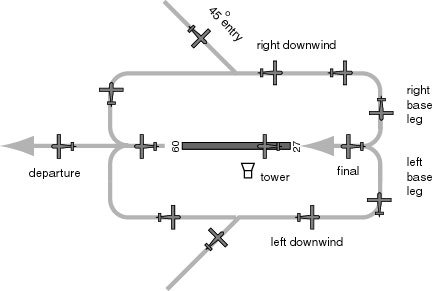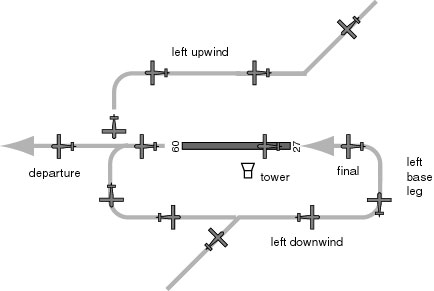
There are two different procedures commonly used to control air traffic around busy airports, one for aircraft under instrument flight rules, and one for visual flight rules. All commercial airline traffic as well as large corporate and transport aircraft generally operate under instrument flight rules even in good weather. So they are generally handled as in instrument flight, i.e. they are given radar vectors until they make visual contact with the aircraft ahead of them (weather permitting), after which they simply follow one behind the other adjusting their separation by eye. This is a safe and practical procedure that moves the traffic very efficiently, although it bogs down when the weather gets bad, when the separation between aircraft has to be increased. This is because a pilot can do a much better job of maintaining separation visually, since he only has to worry about the separation from the aircraft immediately ahead of him, and can make constant corrections to his speed and power setting without clearance from the controller. In bad weather on the other hand the controller must manage all of the separations of the aircraft under his control, and every change of speed must be requested explicitly by radio.
Under visual flight rules the system works quite differently. Each aircraft calls in as they approach the airport, and are given instructions how to enter the traffic pattern. They then report to the tower as they enter the pattern as they were requested, and the controller attempts to sequence them behind another aircraft ahead. This procedure would work well enough if all the traffic were to circulate in the same direction. However the standard procedure at control tower airports is to maintain two separate traffic streams, one circulating clockwise (right traffic, i.e. making right turns) and the other circulating counter-clockwise (left traffic). These two streams converge on the left and right base legs, to merge into a single stream on the final approach leg. This merging of two traffic streams under the controller's direction is the most difficult and dangerous aspect of the standard traffic pattern procedure.

The toughest job of the controller is to sequence the two flows together on final. When traffic is light, this is not too difficult, since the controller can see the aircraft well enough, and traffic flows relatively easily. When the traffic gets heavier however the system breaks down. As traffic backs up along the final approach leg, both the left and right downwind legs extend out farther from the airport, until the controller can barely make out the aircraft on base leg as little black dots. Although he can see their altitude fairly well, it becomes very difficult for him to accurately judge their distance from the field, and he can no longer see their color or identity, thus he is prone to mis-sequencing the aircraft on base leg. This leads to a condition where pilots, who are themselves busy preparing their aircraft for landing, find themselves head-on with another stream of traffic, and often there is frantic last minute maneuvering to correct for errors by the controller. The problem is that the controller is responsible for sequencing, but the pilots are in a much better position to observe who is closer, and therefore they could more easily sequence themselves, like cars converging at an intersection.
But the turn from base leg to final occurs at a most critical time for the pilot, when he should be concentrating on preparing his aircraft for landing. The funneling of streams of traffic in opposite directions head-on to each other at the last and most critical turn in the pattern is the most ridiculous arrangement that could possibly be organized. Furthermore, making the controller, who may be three or four miles away (and very busy) responsible for sequencing individual aircraft at this critical juncture, is even more foolish. The volume of very critical radio traffic to sort out this mess is so great that there is often no break between frantic transmissions, all exacerbated by the fact that whenever two people transmit at once, or "step on" each other, everybody knows about the mistake except the two involved. When it is the controller who is "stepped on", it often takes two or three additional transmissions to sort things out again. All of this gives us the impression that at many tower airports, traffic has reached saturation density. Nothing could be farther from the truth.
Let us consider which operations are difficult and dangerous in visual air traffic, and which operations are easy and safe.
Consideration of the above factors illustrates how our present system of air traffic control is absolutely the worst it could possibly be, since the choice in every case is for the difficult and dangerous option, rather than the easy and safe. You can see that the major problem is the convergance of traffic streams from the right and left base legs. How can this be avoided?
The solution is simple; make all traffic rotate counter-clockwise. Consider a runway 09/27, with traffic landing on runway 27. Aircraft from the south should turn right and enter a left downwind, while aircraft from the north, by default, should turn right before reaching the airport and turn right into a left upwind, i.e. parallel to the traffic that is taking off. When traffic permits, at the controller's discretion, aircraft in the left upwind leg can turn left and cross the runway, then left again to enter the left downwind and merge with the left pattern traffic directly over the field, in full view of the tower. If the traffic is more busy, they would continue in the upwind until a gap in the left downwind presents itself, at which point they could cross over to the downwind. If the traffic is extremely busy, the upwind leg can be extended indefinitely out to the west, at no danger or inconvenience to anyone. Traffic from the south should enter the left downwind at a 45 degree angle (as is the usual practice), so as to merge more easily with that traffic stream

You can see that with this scheme, all traffic merging occurs at high altitude and far from the final approach, and usually in full view of the tower, who would be in an excellent position to make speed and distance judgements for the merge. The rest of the traffic pattern is self-organizing, with aircraft following in line-astern in a single traffic stream from downwind to base to final. The aircraft can space themselves as they see fit, without need for any intervention from the tower, thus greatly reducing radio traffic. In fact, the only role of the tower is to sequence the traffic once, as they enter the pattern, and they could devote their full attention to the merging of traffic over their heads, while aircraft in the rest of the pattern adjust their own spacing to the aircraft ahead, in a long line-astern trail. In fact this is how traffic is organized in instrument flight rules, except that the merging is performed by radar rather than by visual observation. This scheme is particularly suited for very heavy traffic, because the upwind and downwind legs can be extended indefinitely without any increased danger, since the controller is not needed to observe or make judgements for that traffic.
In the case of departures, the aircraft climb straight out until clear of the traffic, flying parallel to the upwind traffic, who could thus see and avoid them all the better. Go-around or touch-and-go traffic climb straight ahead until a gap appears in the downwind leg for them to merge in. If the traffic is very busy they could even be directed into the upwind leg to merge again in full view of the tower and at a shallow angle.
Large and fast aircraft like airliners and business jets could follow exactly the same scheme, but farther out and higher up, perhaps at 2000 instead of 1000 AGL, and merge with the regular traffic from a long final. That way, the tower would instruct the smaller traffic on downwind to follow the jet. The small craft would then extend their downwind until abeam of the jet, then turn and follow it in. The sequence and timing for the turn can be left to the small craft pilot, since he is in the best position to judge the spacing. The tower need not even concern themselves with which small craft should be the last to land before the big one- each pilot would judge for himself whether there is room to land before the big one gets too close. If he makes a mistake and the jet catches up with him, he could be directed back up to the upwind leg to make another circuit.
Return to Steve Lehar